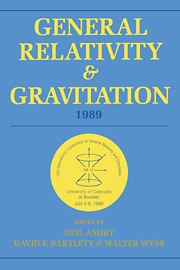 General Relativity and Gravitation, 1989
General Relativity and Gravitation, 1989 Book contents
- Frontmatter
- Contents
- Preface
- Conference committees
- Part A Classical relativity and gravitation theory
- WORKSHOPS
- Part B Relativistic astrophysics, early universe, and classical cosmology
- WORKSHOPS
- Part C Experimental gravitation and gravitational wave detection
- WORKSHOPS
- C1 Solar system and pulsar tests of gravitation
- C2 Earth-based gravitational experiments
- C3 Resonant bar and microwave gravitational wave experiments
- C4 Laser gravitational wave experiments
- Part D Quantum gravity, superstrings, quantum cosmology
- WORKSHOPS
- Part E Overviews-past, present, and future
C2 - Earth-based gravitational experiments
Published online by Cambridge University Press: 05 March 2012
- Frontmatter
- Contents
- Preface
- Conference committees
- Part A Classical relativity and gravitation theory
- WORKSHOPS
- Part B Relativistic astrophysics, early universe, and classical cosmology
- WORKSHOPS
- Part C Experimental gravitation and gravitational wave detection
- WORKSHOPS
- C1 Solar system and pulsar tests of gravitation
- C2 Earth-based gravitational experiments
- C3 Resonant bar and microwave gravitational wave experiments
- C4 Laser gravitational wave experiments
- Part D Quantum gravity, superstrings, quantum cosmology
- WORKSHOPS
- Part E Overviews-past, present, and future
Summary
Though historically, the solar system has been the principal area for testing theories of gravitation, we seem to be at the end of the golden age of solar-system tests (Reasenberg (1987)). The classical effects have now been measured within the limits of today's technology and further significant improvements cannot be expected in the near term. Future space-based experiments such as GPB, Gravity Probe B; LAGOS, Laser Gravitational-Wave Observatory in Space; and POINTS, the (proposed) Astrometric Optical Interferometer, await further technological as well as engineering developments and logistic (launch) support to deliver them to the laboratory of space.
Recent years have seen, however, ground-based gravitational experimentation undergo a resurgence, driven by new experimental capabilities and by new theoretical work. The question that was raised by Fischbach et. al. (1986) of a possible short-range gravity force, dubbed the “Fifth Force,” has been particularly important. Though the experiments that gave rise to this suggestion have, in retrospect, turned out to be less compelling than was originally thought, the gravitational physics community has been forced to recognize the possibility of a short-range gravitational interaction.
This suggestion lent itself to fairly straightforward testing and the experimental community responded with great enthusiasm and ingenuity. Now some five years later, though it appears that this quite plausible theoretical suggestion has been ruled out by experiments at the level which initially was suggested. Nevertheless it gave rise to a rather exciting period in gravitational physics.
- Type
- Chapter
- Information
- General Relativity and Gravitation, 1989Proceedings of the 12th International Conference on General Relativity and Gravitation, pp. 345 - 348Publisher: Cambridge University PressPrint publication year: 1990
